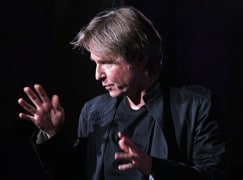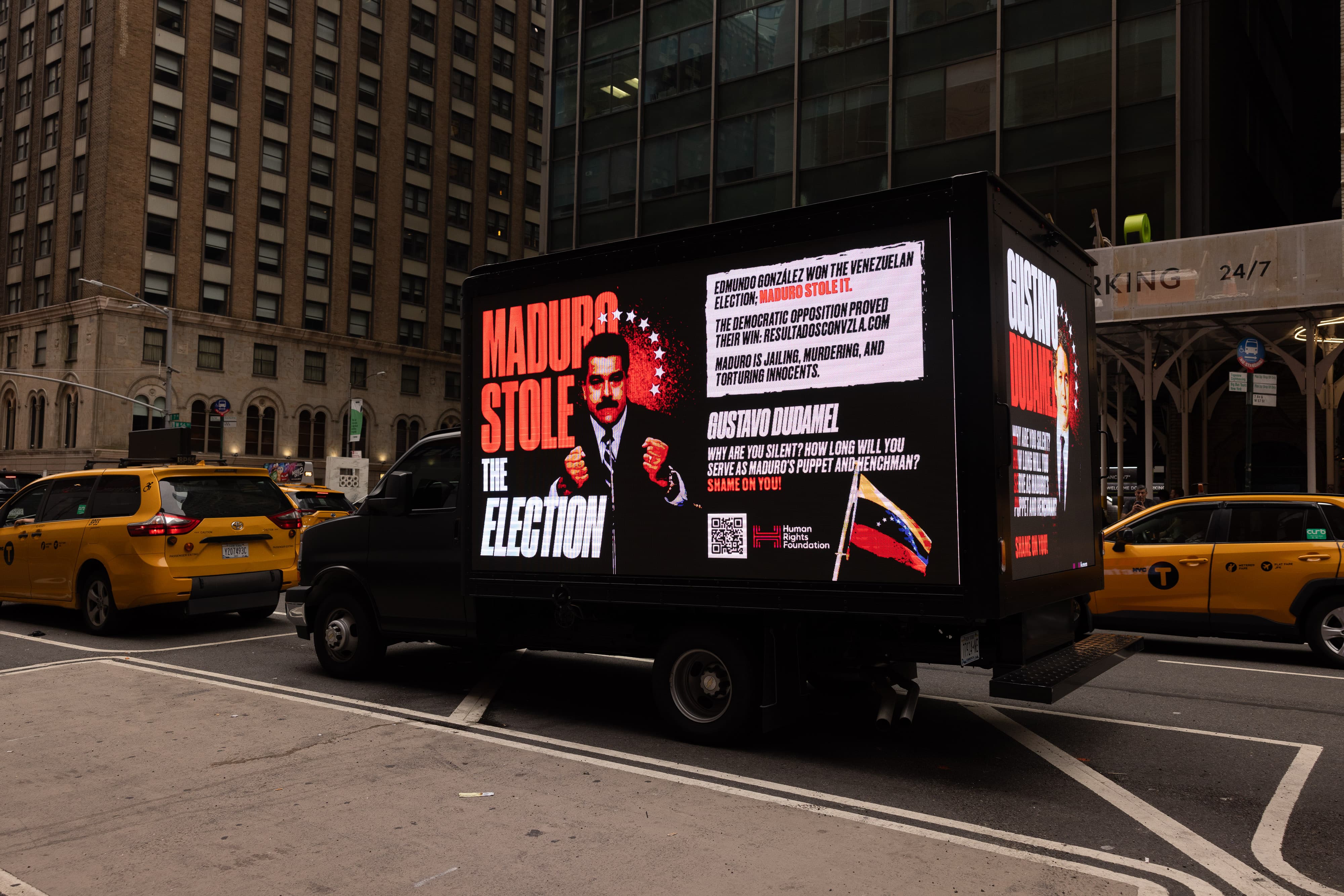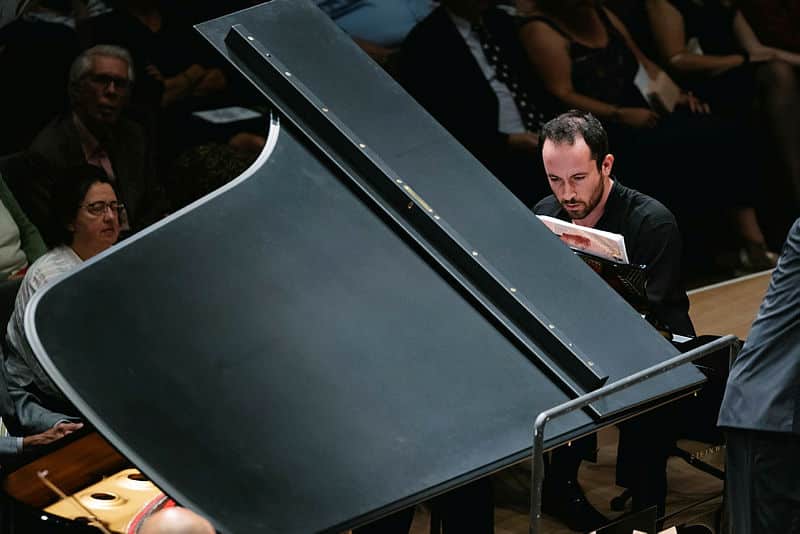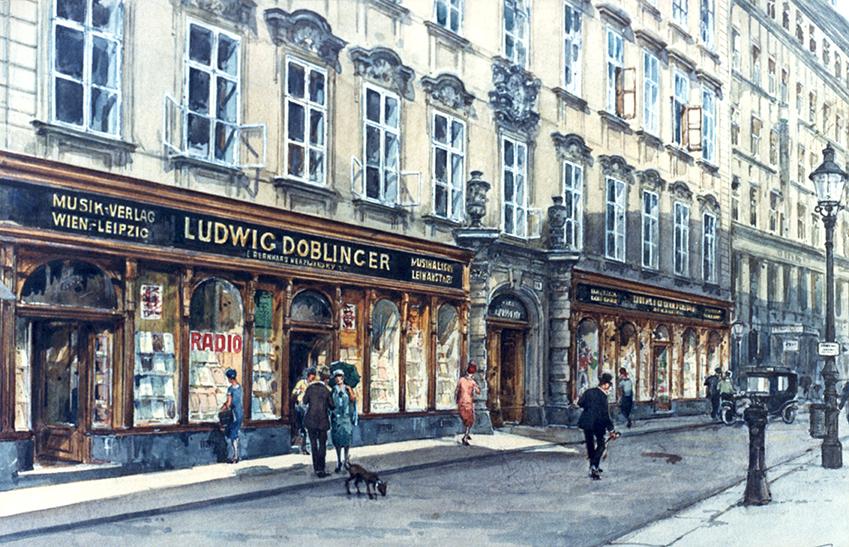Esa-Pekka Salonen: ‘I don’t mind applause between movements’
mainThat’s his answer today in a Guardian questionnaire.
We think he’s the first front-rank conductor to endorse a more relaxed concerthall etiquette.
Anyone else care to bend the rules?

For a qualifying opinion, see here.





In Italy it always felt normal to receive applause after a particularly well played movement.
Rules, especially silly ones, are made to be broken: http://www.tchaikovskiana.com/tchaikovskiana/a-minor-note
Absolutely concur. If they did it back in the day, maybe it is time to bring that day back.
It seems to me that if they are applauding that means they enjoyed themselves and appreciated the performance – and that’s a good thing, right?
Or maybe they’re going to a classical concert for the first time and don’t know the old “rules” – new audiences are a good thing, right?
Applause between movements is probably the last thing classical performers should be worrying about.
The funniest moment in Lorin Maazel’s movie about the life of a conductor, is at the end of the third movement of Tchaikovsky’s 6th, where of course the audience claps, the conductor turns to them and says “Philistines!”. Now whenever I hear the 6th in concert at that moment I have to suppress a good chuckle.
I was recently at a concert at Wrocław’s splendid new Narodowe Forum Muzyki (the acoustic in the Sala główna really made me appreciate what we are missing out on with the Royal Festival Hall and Barbican Hall). Despite an announcement at the beginning of the concert, in Polish and English, asking people to save applause until the end of each whole piece, most of the audience applauded between every movement (except where movement were performed attacca). The conductor, Eiji Oue, was clearly displeased, as was I!
It seems that when most performers are asked about applause between movements they say that they don’t mind, or even like it, whereas most serious concert-goers seem to hate it. At least the absurdity of my position is never lost on me when I think to myself that I hold audiences to a higher standard than that to which the performers hold them! For me, though, applause between movements really does ruin the overview of the whole work, the opportunity to hear the whole composition as an uninterrupted totality. Of course, that was not necessarily even how the composer himself would have expected the work to be performed, but it is what audiences became used to at a certain point, and it is what some of us like.
I hate to be the one who points it out: but Mr. Salonen does actually say what you claim. He adds a rather important caveat.
I hate to be the one who points it out: but Mr. Salonen doesn’t actually say what you claim. He adds a rather important caveat.
Worth repeating.
And “doesn’t mind” does not mean “welcomes”.
The three or four movement structural form developed by Haydn and greatly expanded upon by composers for the next century, is carefully conceived and composed as an architectural unity by composers. The structural, thematic and tempo relationships between the movements are carefully worked out to create the overall arch of the work. Applause between the movements breaks the unity of the larger form of the composition.
Applause between movements is just one of many superficial ideas that are currently fashionable in the attempt to make classical music more approachable in an era when arts education has eroded people’s understand of the genre. The best approach is to tolerate applause between movements when audiences lack the basic education to understand multi movement forms, but at the same time to work toward better systems of education. *If appropriate* one could even give a short explanation before the work about its constituent parts and how they form a whole, perhaps even with a few excerpts as a demonstration.
yes, of course. you’re absolutely right. no-one ever clapped between movements in Haydn’s day. ahem.
As if that made it right. Must have been those powdered wigs. Ahem. Ahem. The problems with applause between movements is obvious. More interesting is how Salonen invariably supplies a few bon mots to support the fashionable status quo (like applause between movements.) If only his drollery were more successful at disguising what seems to be his carefully calculated conformity. We need more mainstream artists in the classical music world willing to genuinely stand apart – even if mainstream and standing apart are a bit of an oxymoron.
And by the way, in Haydn’s day, his music was often played in the background while aristocrats were partying and barely listening at all. Maybe that should be the next step in our profound search for musical relevance…
Sir Mark Elder made a speech before a Hallé performance of the Pathetique symphony, specifically asking people to applaud where it felt natural – it felt so great to applaud properly after the 3rd movement – the music is written in such a way that it’s totally unnatural to withhold applause.
It’s so important that nothing is done to stifle the emotional response of the audience. If that means applause, whistling, screaming, cheering, then so be it! It’s nothing to do with pandering to new audiences, it’s just what feels natural.
Incidentally, here’s a witness at the premiere of Beethoven 9:
“the public received the musical hero with the utmost respect and sympathy, listened to his wonderful, gigantic creations with the most absorbed attention and broke out in jubilant applause, often during sections, and repeatedly at the end of them.”
Indeed, we see an evolution of musical reception from Haydn as a court musician to Beethoven as a celebrated concert composer. As the understanding of music grew, so did our concert etiquette. People began to understand that Haydn was far more than a court musician writing background music; that the work of composers required informed, dedicated listening; and that multi movement works more often than not defined single larger structures.
At the same time, the concepts of multi movement works continued to grow in sophistication. By the time of Mahler, the narratives defined by symphonic movements began to almost take the character of dramatic art forms with the transitions carefully planned. Some composers even expanded on multi movement symphonic forms, adding many more movements with defined structural continuities such as Elgar’s Enigma Variations, Holst’s Planets, or Mahler’s Das Lied von der Erde. Some 20th century composers, like George Crumb, even defined in the score the number of seconds that should exist between movements of his works.
There’s nothing wrong with the occasional spontaneous outburst after a movement that has been exceptionally well done, but to encourage applause between movements *as a general principle* is to ignore these important historical developments and the conception composers had of their multi movement works as unified wholes. It seems to be a manifestation of our time where music is regarded principally as a sensual indulgence that precludes any necessity for an informed system of aural awareness.
No need for music education. Like man, just do whatever feels “natural” because its like awesome dude… It’s OK to begin there, but can’t we use education to at least eventually take people a little farther?
That is a very good contemporary witness account that illustrates clearly how intent listening and applause were not seen as contradictory activities. And there are other accounts like it in relation to Mozart, etc. I myself am used to listening in silence. That after all is how I and so many others today grew up enjoying live music. But it is always good to bear in mind that other eras did not have the same customs. Moreover, although there certainly was much superficial listening back then, what strikes me about these accounts was that it was precisely the most avid listeners who applauded so vigorously, even during the course of a movement. Their actions reflected the fact that they were indeed actively taking part in the music.
To turn it around, if Beethoven or Mozart (and, one can assume, Haydn and any number of others from that time), were confronted with our response customs, their reaction would inevitably be that the audience was either not paying attention (and hence superficial), or was not excited and moved by the music. In other words, our audience response would likely be very disappointing to them. If that first audience had sat in complete silence for the new 70 minute Ninth, Beethoven, in light of the customs of his era, would have felt that he had failed them in some way. But as we all know, the work was one of his great successes.
What we have today is a clash of customs. Some want to bring the old ways back and others do not. I see no easy way to resolve that in such a way as to satisfy everyone.
What a load of tosh! “It’s important that nothing is done to suppress the audience’s emotional response to the music” After a smug idiot standing next to me at this year’s Proms insisted on clapping the very second the BSO finished Mahler 6 (no meaningful silence there) even though Nelsons was obviously holding on for a few seconds, I decided the Proms could do without me. On the radio today I came in in the middle of a performance of the Enigma Variations. Clapping after Nimrod. Must be a concert from Outer Mongolia, I thought. No, of course, it was from this year’s Proms, where there seems to be a clapping mafia. We used to send gays to prison, horses used to sh*t in the streets. Let’s bring back the Gòod Old Days!
I suspect that you and many others read too much into the message when audience members applaud (or an entire audience applauds) in between movements.
For them, I doubt it is a purposive “superficial idea.” It’s just an instinctive response to the end of a coherent piece of music. They merely hear what sounds like the end to them, then show their appreciation.
In his multi-volume tome, Taruskin discusses the church-like solemnity of the current esthetic of withholding clapping in between movements. (The volume containing that observation is not in front of me as I type this, so I can’t cite it.)
I prefer withholding applause to the end of a work (and prefer it when the audience does so when I am onstage), even as I recognize that there are times when applause in between movements may actually be more natural.
This is especially true when what may seem like the end of a movement really isn’t, such as the end of the first movement of the Mendelssohn Violin Concerto, which has the subtle transition to the second movement.
Yet contrast this with applause practices in the opera house, where applause at the end of an aria or even a part of an aria can occur.
I have no clear cut opinion on this. I guess it all depends on the work performed, on whether you have strongly independent mvts (think of a suite from a ballet) or a more organic, integrated whole, where applause between mvts could really be disruptive. Of course we cannot trust audiences (ourselves included) to always be able to make this distinction, so I would argue in favor of a no-applause rule of thumb.
On the other hand, I am not sure that an enthusuastic round of applause is more annoying than the usual concerto for coughers and paper-rustlers…
Yes, I would exchange a lifetime’s clapping after the 3rd movement of Tchaikovsky 6 for the expulsion of full throated coughers and paper rùstlers.
Add mobile smartphones
For the record, this is not Mr. Salonen’s first statement on this topic. In an interview I did with him 19 years ago, he had this to say about applause between movements: “I don’t see any practical value in the [no- clap] rule. There’s no aesthetic or artistic ground for it. We know that the people went bonkers after the movements at the premiere of Beethoven’s Seventh. This is something that should be a matter of the individual preferences of the listener.”
My piece ran in the Hartford Courant, as well as other papers via the LA Times/Washington Post newswire, and later, in modified form, in Symphony Magazine.
The notable point here is that we see how long these faddish ideas about new concert etiquette have been around, and worse, how few results they have produced. Applause between movements, casual attire, alternate venues, movie music, light shows, video, cross-over music, etc., are all well and fine, but they will never be a substitute for music education and effective funding systems.
Yesterday I heard a live recording of Enescu’s first symphony. The first movement ended with all the bombast, timpani, bass drum and all you’d expect of a grand finale. People immediately applauded before they were hushed. Somehow the applause felt much more natural than the silence.
However, I would hate applause between an Adagio that ebbs away, with the following silence clearly implied by the music. More empathy, less etiquette!
Barenboim does not mind either. He made a speech to the Chicago audience years ago to that effect – he told them to be spontaneous and show their appreciation by clapping whenever they felt like it.
I just don’tget it. ‘Clap whenever you feel like it.’ In the middle of the Matthew Passion? After the second movement of Beethoven 9? Halfway through Barenboim playing a hairy passage in the Hammerklavier?
Applause between movements, such as after the scherzo of Corigliano’s Symphony No. 1, or Martha Argerich’s stunning first movement of the Schumann concerto, as well as the March of Tchaikovsky’s Pathetique, are much more acceptable than the Philistine with a score in the front row who broke the spell Sawallisch wove at the end of Gorecki’s “Symphony of Sorrowful Songs” with singularly wild and loud applause! All these have been witnessed with the Philadelphia Orchestra. Let them applaud, if stirred. Let them not break the silence if the conductor’s hands are raised.
William Osborne would to well to avoid concerts at the Orange County (CA) Performing Arts Center where audiences, no matter which orchestra is on the stage, applaud EVERY movement. At least that was the case when I lived in LA (until 2000).
Like Osborne, I’m a listen-and-applaud-after-the-piece guy, but hell, if people applaud after a movement, and it’s OK with Essa-Pekka (and, by the way, Artur Rubinstein) and more than a few others, my life won’t be ruined by it.
If Osborne is waiting for better music/arts education to solve this and other problems, he’s in for a long wait, at least in the US, where the Common Core and testing-testing-testing have become the order of the day in the effort to make the educational system more business-friendly. In the meantime, he’d do well to accept that the people around him whose artistic maturity isn’t as evolved as his will continue to show their approval for what they’ve heard in the conventional way people do that.
Applause between movements is especially welcome when it muffles the collective coughing that makes such a hideous contrast to good music.
Another reason to dislike the guy. Thanks for the tip.
It depends of the piece. If the symphony movements are not connected each to others through the same themes, or general ideas- why not? But in some symphonies , even if it not written “attacca”, the applause between the movements can destroy the composer’s intention, and ruin the form.
David Robertson in Sydney encourages applause between movements, turning around saying things like: I liked that bit too.
There’s applause and applause though – that which spontaneously follows something genuinely wonderful, and that which comes, often awkwardly, simply because the music has stopped.
I don’t have any strong opinion about it, but I tend not to applaud because I want to save my energy to applaud at the end. I do have a special place in hell for those twits who tend to appaud too soon in the dying chord of a Wagner opera or a Mahler symphony (the ones that end quietly, anyway).
That said, I reject this notion that the between-movements applause thing is somehow related to making classical music more accessible and less elitist. Every activity has its behavioral norms, which the regulars know and the newbies can figure out if they pay attention. Plays, movies, rock concerts, jazz clubs, religious services, baseball games, blackjack tables, and so on. Nobody talks about “elitism” and “approachability” in all of these places. If you don’t know how to act, watch the person who does. Simple enough.
I conducted a concert a few years ago of music by Mozart and his contemporaries. I told the audience a thing or two about performance practice in those days and also about what audiences were like in those days. Might as well be consistent, right? I invited them to express themselves not only between movements, but even while we were playing if the spirit so moved them. Everyone had a ball, including the musicians, who found themselves actually playing FOR REAL PEOPLE in order to elicit a response. The concert hall is not a church and a concert is not a religious service. As long as people turn of their damn cell phones and have a good time is all that matters.
A few seasons ago I conducted the “Pathétique”, and prefaced it with an offstage request via the PA system. I asked the audience to be the first in anyone’s memory not to applaud following the third movement, so that the impact of going from its juggernaut of energy into the cry of pain that begins the finale could be as keenly felt as possible. They complied. Musically and dramatically, it was a very satisfying moment.
Very well said. In general, I don’t mind applause after movements that end big, but Tchaik 6 is a special case as eloquently described by you. Applause that ruins silence after quiet endings, however (I call it premature appreciation), might some day make me a murderer.
Applause between movements doesn’t bother me as much as any audible form of audience approval after those pieces that, if performed well, I believe should leave one moved to tears. Examples: Wozzeck, Tchaikovsky 6, Mahler 9 and Das Lied von der Erde. Otello and Billy Budd almost fall into this category as well.
I’m all for it! Funny that the same conductors who have no issue with the audience clapping during an opera they are conducting, throw fits when an audience member claps, sneezes or coughs! Hypocrites!
When an aria is over, the audience claps – at times lasting while the music goes on…are Mozart’s immediately after one of his arias any less important?
With dying audiences, any clapping that gets the audience member to relieve their honest enjoyment, should be welcomed!
I’m all for it! Funny that the same conductors who have no issue with the audience clapping during an opera they are conducting, throw fits when an audience member claps, sneezes or coughs! Hypocrites!
When an aria is over, the audience claps – at times lasting while the music goes on…are Mozart’s notes immediately after one of his arias any less important?
With dying audiences, any clapping that gets the audience member to relieve their honest enjoyment, should be welcomed!
Well, if the orchestra think it’s fine, if all audience members think it’s fine and the music will benefit from it, then go ahead and applaud also during the movements for my taste.
Of course, this is another desperate attempt to “open up” classical music: “Come look at us! Sometimes we play in t-shirts and you can applaud when you want! (and thousands flock to the hall)
Yo may call it a “desperate attempt to open up”, but for me it is a realistic effort to improve connection between performers and listeners that can benefit both sides.
My unfortunate way of spelling “you” without “u” in the comment above was unintentional.
It’s sometimes hard even for educated listeners to hold their applause after an exceptionally well played movement and it does not always break the unity of the work. In the old times, we know audiences would get full movements repeated. But definitely no to applauding after each movement.
I am more disrupted by the tradition of applauding repeatedly during opera or ballet performances. This really breaks the atmosphere and unity of the work.